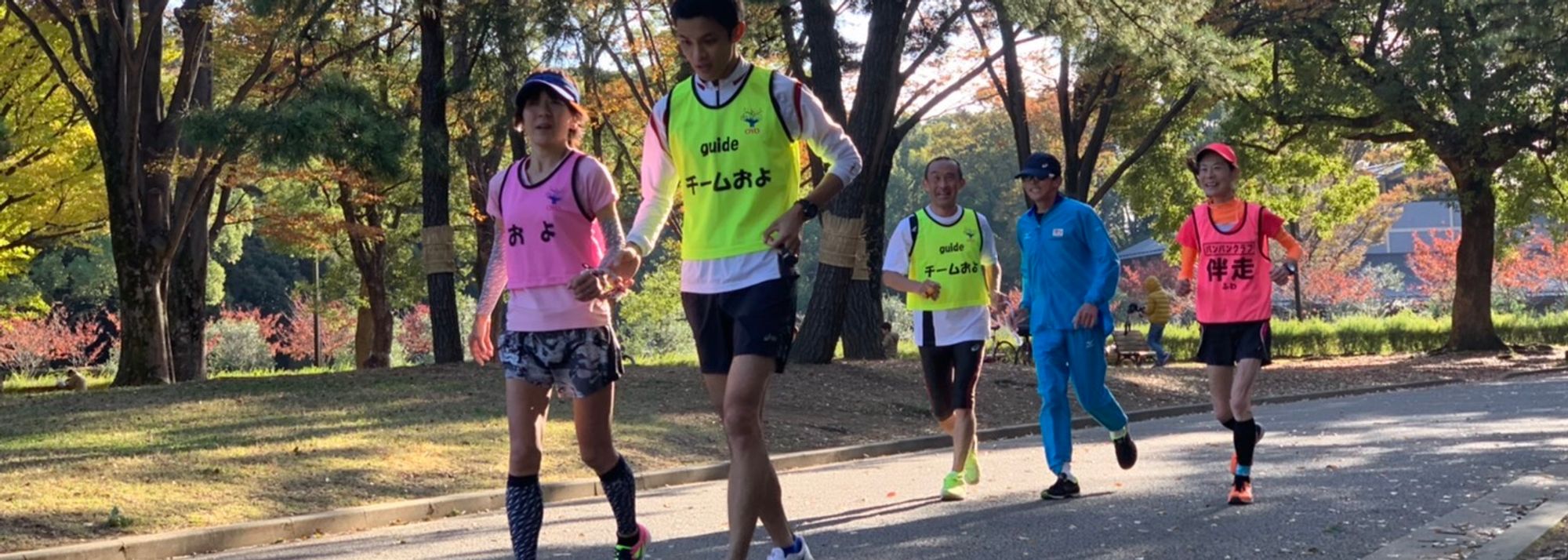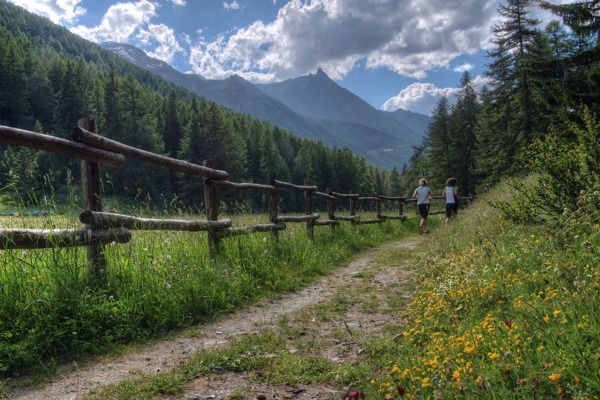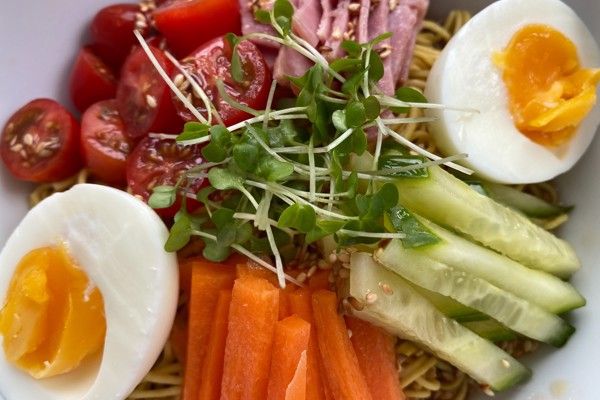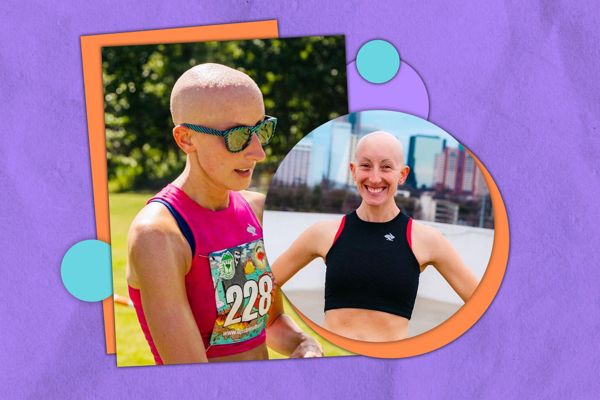Yoko Aoki training (© Yoko Aoki)
Running alone, at a time that is convenient for you, is one of the joys of this simple sport that many of us take for granted. Just putting on your shoes and getting out into the fresh air, clearing your head, running as far and fast as you like… running is a simple remedy for the stresses of modern life.
But for Yoko Aoki, one of Japan’s top runners with a visual impairment, running is not quite so simple. She always runs with a guide runner. Planning ahead and coordinating her large team of guide runners is a normal part of her running schedule, on top of the physical and mental challenges of training hard and competing at elite level. I caught up with Aoki and her team to hear about the enjoyment and challenges of running with a guide.
Aoki, 45, suffered a detached retina after leaving senior school, and competes in the T12 category. She took up marathon running in 2008 and has gone from strength-to-strength ever since, setting her personal best of 3:09:55 in December 2019. Working full-time for NTT Claruty Corporation, a special subsidiary of NTT, alongside running, Aoki is supported by the Japan Blind Marathon Association (JBMA), which has helped to make Japan a powerhouse in distance running for visually-impaired athletes.
Under the guidance of head coach Yoshihide Fukuhara, himself a visually-impaired athlete, Aoki’s team, ‘Team Oyo’, consists of around 30 guide runners in total. She runs every morning before work with guide runners who live near her home. Aoki coordinates this rota herself. On Wednesdays and Sundays, she runs speed sessions in a local park or on a running track, overseen by Fukuhara. At each of these sessions, five guide runners will accompany her, one by her side and others running in front and behind.

With Aoki’s impressive speed, it isn’t always straightforward finding enough guide runners who are fast enough to keep up with her. Her team consists of men and women of various abilities. Morning runs tend to be easier runs, but for speed sessions the number of guide runners she can call on who are fast enough is limited. Naoki Okumura is one of the faster guide runners in her team. “I can keep up in terms of speed but the height difference between me and Aoki makes it tough”, he explains. “I am about 30cm taller than her, so I have to adjust my stride length, and drop my arms to suit her running action”. Coach Fukuhara says changing your form takes time; it is easy enough for the guide runners over short distances but to run a long way with an unnatural form is tiring. This is a common challenge in Team Oyo – the faster runners who can keep up with Aoki are mostly the men, but they are, on average, taller than her. So for Fukuhara, an integral part of planning Aoki’s training menu is thinking which guide runners can complete sessions with her. As Aoki improves, so too must her guide runners. “I want her to get faster, but then it is tough for me too”, laughs Yasuhiro Ukitsu, one of the speedier men in the group.
Aoki lives in Tokyo, but training in hot, humid Tokyo summers is tough. So Team Oyo will spend time in Hokkaido and at altitude in Nagano on training camps this summer. For marathon competitions, visually-impaired athletes use two guide runners, who exchange the running tether at the half-way point. Deciding who will fill these two crucial slots in races is something Aoki discusses at length with her team. All three of them must be on top form to ensure a successful result.
Being a guide runner to a world-class athlete may seem like a heavy responsibility. But all of Aoki’s guide runners who I spoke with had only positive experiences to report. Safety is the top priority for all of them. Avoiding potholes, warning her about upcoming steps in the pavement, and steering clear of cars, bicycles and pedestrians is paramount. But that is only one small part of being a guide runner. “Aoki is training hard and trying her best in a stressful environment, so I often check to make sure she is not overdoing things, or suffering too much”, explains Makiko Yokoyama. In competitions, helping Aoki to beat her rivals also comes into play. “I help with pace judgement, monitor how Aoki is doing, and give her tips on how to win”, explains Hiroyuki Takada, who ran the second half of Aoki’s PB-breaking race in 2019.
But being a guide runner isn’t all about running. “I describe the scenery, identify flowers that are in bloom, and tell her the name of any restaurants we pass whose food smells delicious!” explains Ukitsu, who also ran with Aoki when she set her PB. None of the Team Oyo guide runners has formal qualifications, but they’ve learned from more experienced guide runners and training events organised by the JBMA. All of them train hard, on top of work and family commitments, to maintain their fitness so they can accompany Aoki. Running to and from work is a popular time-saving way of fitting in training for some of them.
For Aoki and her team, the running they do together builds connections, and creates so many opportunities for shared enjoyment. “Many people think guide running must be difficult” says Okumura. “But with a little care, anyone can do it. Aoki is a competitive athlete but many people with visual impairments simply want to walk or jog. Just give it a go”, he says. For Ukitsu, helping Aoki has given him more motivation for his own running. “If I tell Aoki to try her best in the last, really hard 1km of a marathon, then I must do the same. When I am in races by myself, I really give it my best at the end”.
Fukuhara sums it up: “Regardless of disability, age, or gender, simply by running together and talking, we meet new people, enjoy the same activities, and break down walls between us”. Aoki explains that by running or walking with someone who cannot see, your world expands. You can gain some sense that you did not have before, and the breadth of your life will expand. “More than accompanying another runner, it’s about enjoying something together as friends,” she says. “You might notice much more of your surroundings while running as a guide."
Aoki wants to spread awareness about the world of running for people with visual impairents, and being a guide runner. She and her team work incredibly hard together. It isn’t all about running, but about human connections, enjoying a variety of experiences together, and making friends.
Mara Yamauchi for World Athletics Be Active
青木洋子:ランニングを通じて世界が広がる
一人で都合の良い時間に走る事はシンプルなスポーツであるランニングの一つの当たり前の楽しみです。ただ靴を履いて、爽やかな空気に囲まれ、頭をすっきりとして、自分が好きな距離やスピードで走る事。。。近代生活のストレスに対してランニングは簡単な薬です。
しかし、日本の視覚障害を持っている力強い選手の一人として青木洋子選手にとって、ランニングはこんなにシンプルではありません。彼女は必ず伴走者、つまりガイドランナーと一緒に走ります。エリートレベルで競技を出場、それから辛い練習の肉体的および精神的な挑戦の上で、前もって計画を立てて、彼女の大きいガイドランナーのチームを調整する事がランニングスケジュールの普通の部分となっています。青木さんとガイドランナーの皆さんと伴走付きのランニングの楽しみと挑戦について話し合いました。
青木選手(45歳)は高校卒業後、網膜を剥離したためT12のカテゴリーで競技に出場しています。2008年にマラソンを始めて、2019年12月に3:09:55の自己ベスト更新をしたことを皮切りに、どんどんと強くなってきています。マラソン競技をすると同時に青木さんはNTTの特例子会社(NTTクラルティ)で社員としてフルタイムで勤務しています。また、視覚障害を持っている選手の長距離競技で日本が強くなる大きなサポートをした日本ブラインドマラソン協会(JBMA)のサポートを受けています。
視覚障害選手である福原良英監督の指導に基づいて‘チームおよ’と呼ばれ、青木選手のチームはガイドランナー合わせ合計で30人程います。毎朝青木さんは家の近くに住んでいるガイドランナーと一緒に走っています。このスケジュールは青木さんが自分で調整します。水曜日と日曜日に近くの公園か陸上トラックでポイント練習を行います。このポイント練習の調整は福原監督の責任下で行われます。ガイドランナーは隣に一人、そして前と後ろにも、合計5人で伴走します。
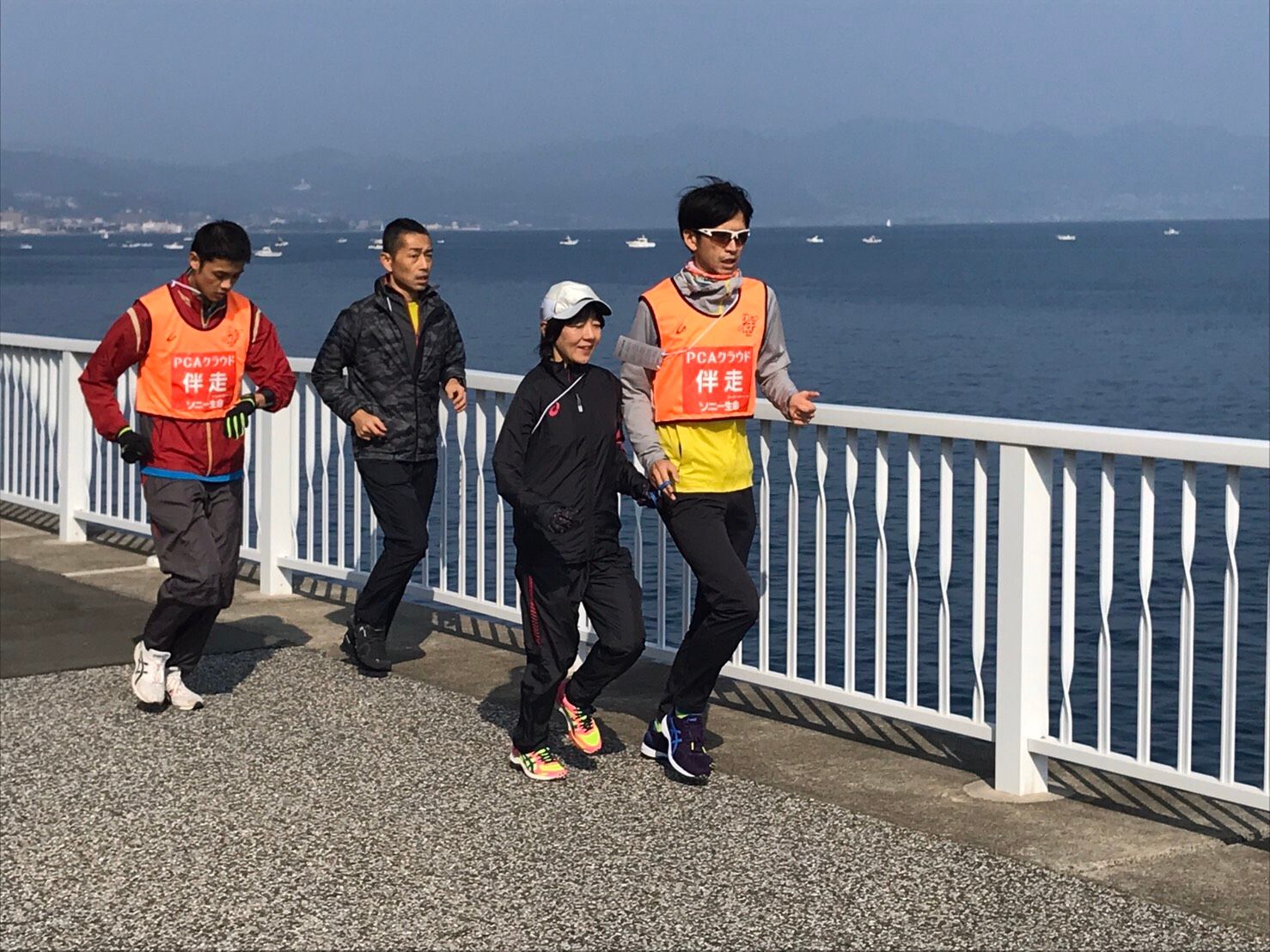
青木選手の優秀なスピードを考えると、彼女に付いて行ける十分なスピードのあるガイドランナーを数多く見つける事は簡単ではありません。彼女のチームには男女様々なレベルのガイドランナーがいます。朝練ではそれほどペースは速くないのですが、ポイント練習で付いていける速いガイドランナーの人数は限られています。‘スピードは付いて行けますので問題ないですが、身長の差が30センチぐらいで、青木さんの走り方に合わせるためにストライドを調整したり腕を下げたりしないといけませんね’、と速いチームメンバーの奥村直樹さんは語っています。福原監督は‘フォームを変える事は時間がかかります。短距離なら、不自然な走り方は大丈夫ですが、長距離になると疲れますね’と説明しています。これはチームおよのよくある挑戦です。青木さんに付いて行けるガイドランナーは男性が多いですが、身長は平均で青木さんより高いです。福原監督は練習メニューを考えると、ガイドランナーもが走れるか想定しないといけません。青木さんが速くなってくると、ガイドランナーの皆さんももちろん速くならないといけません。‘青木さんに速くなってほしいですが、そうすると僕も大変です’とペースが速い男性のチームメンバー浮津康宏さんが笑って話します。
青木さんは東京に住んでいますが、熱くて湿度が高い東京の夏で練習する事が辛いです。なのでチームおよはこの夏北海道や高地である長野県で合宿をする予定にしています。マラソン大会の時に中間点でテザーを交代するガイドランナー二人に視覚障害選手は伴走してもらいます。青木さんはチームの皆さんと一緒に相談しながら、この大切な二人の枠を誰が務めるのかを決めます。結果を残すように三人とも調子が良くないといけません。
世界レベルの選手のガイドランナーは責任が重いと言えます。しかし、話しを聞いた青木選手のガイドランナーの皆さんは積極的な経験を報告していました。皆さんにとって安全は第一です。穴を避けたり、前にある歩道の段差が来るよと警告したり、車、自転車や歩行者の進路を遮らなかったりする事が大事です。ただ、それはガイドランナーの役割の中ではたった一つだけの部分です。‘青木さんは、日々苦しいトレーニングやストレスの多い環境の中で頑張っているので、少しでも癒しになればと思いながら、無理してないか、辛いことを溜め込んでないかなどを気にしながら走っています’と横山牧子さんは説明します。大会の際は勝負も現れます。‘レース中は、安全確保のほか、ペース配分、体調の変化、勝負どころの判断に注意を払っています’と2019年の自己ベスト更新マラソンの後半を伴走しました高田裕之さんが語ってくれました。
しかし、ガイドランナーは走る事だけが仕事ではありません。‘周りの景色や咲いているお花の話をしたり、レストランから美味しそうな料理のにおいがしてくる時には、どんなレストランかを伝えることも重要です!’と自己ベスト更新マラソンも走った浮津さんが説明しています。チームおよのガイドランナーは正式な資格を持っていませんが、ベテラン伴走者に教えてもらったり、JBMAの訓練イベントへ参加したりしています。青木さんの伴走ができるように、お仕事や家事の追加に皆さんは練習を頑張っています。時間を大事にする方法として何人かが仕事の帰りに帰宅ランもしています。
青木さんとチームメンバーの皆さんにとって、伴走は人たちの間の繋がりができたり、同じ活動を一緒に楽しむ機会も多いです。‘伴走は難しいでしょうと良く言われますが、少しの気配りと思いやりがあれば誰にでもできます。青木さんの場合は競技ですが、視覚障害の方々で歩く事、ジョッギングだけをしたい人が沢山います。気軽にしてみたら良いと思います’と奥村さんが話します。浮津さんにとって、青木さんに頑張ってもらうと、自分も頑張らないと、という気持ちになっています。‘ラストの1キロとか、辛い時に青木さんに頑張って!と言ったら、僕も最後の辛い時も頑張らないといけないですね。一人でレースを走る時でも頑張らなくちゃ、と思います’と説明しています。福原監督はこう話します:‘障害、年齢、男女と関係なく、一緒に走りながら話したりすると、新しい関係ができたり、同じ趣味を楽しんだり、壁を乗り越えられますね’。青木さんは‘目が見えない人と走るとか歩くとかすると、世界が広がっていくと思います。自分にない感覚が得られて、人生の幅が広がっていきます。視覚障害ランナーと伴走するよりも、お友達として何かを一緒に楽しむ事です’と説明しています。‘周りの環境をもっと気が付くかもしれません’。
青木選手はブラインドマラソンの世界と伴走者である事を多くの人に知ってもらいたいそうです。彼女とガイドランナーの皆さんは直向きに一生懸命走り続けます。走る事だけではなく、人間関係、様々な経験を一緒に楽しむ事とお友達を作る事が大事です。
世界陸上連盟ビーアクチブ、マーラヤマウチ
